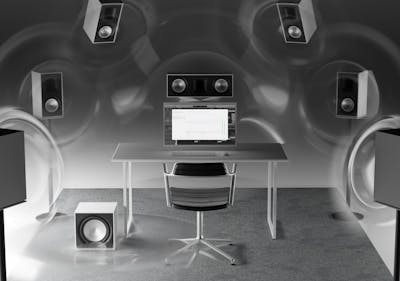So you need to buy headphones for audio work. You compare the spec sheets of a few popular models and you’re not sure what each of the specifications means and if they even matter. We hear you!
The truth is very little of the information found in headphone technical specifications reliably translates to their real-world performance. Frequency response range? Doesn’t tell you anything. All modern studio headphones cover the range of human hearing and beyond. Harmonic distortion? Most spec sheets will state something along the lines of “< 0.1% THD at 1kHz,” which means nothing, as no modern pro headphones will exhibit significant distortion at 1 kHz—it’s the sub-bass range that’s problematic in some models. Impedance should give you an impression as to if mobile devices such as laptops and tablets will be able to drive a particular pair of headphones, or if you’ll need a headphone amp. Impedance doesn’t show you the full picture without taking sensitivity into account. In most cases, low impedance headphones are easier to drive than higher impedance ones, but there are plenty of 250 ohm headphones that can easily be driven from a smartphone. Then there are closed-back, open-back, and semi-open-back designs and different driver sizes and technologies: dynamic, planar magnetic, and electrostatic. The worst bit? Paying more doesn’t necessarily yield a higher quality product that will perform better at the task at hand. Long story short—choosing what headphones to buy can be daunting, especially if you’re new to this.
We’re here to help. We at Sonarworks have measured more than 800 different headphone models (read more about that in our blog article) and have compiled our knowledge so you can easier find answers to your questions. Customers have asked us for years: I have X euros, my use case is Y, what are the best headphones to use with SoundID Reference? This article will try to answer that question and help you find the best tool for your task and budget, in a simple, straightforward manner. While all these models sound great when used with SoundID Reference, that doesn’t necessarily mean that they are good on their own. In fact, some of them have such heavy sound coloration that they’d be a nightmare for any serious audio work right out of the box. However, since SoundID Reference takes care of the frequency response by making it neutral, it is no longer a key factor when considering different models.
This allows us to prioritize properties like comfort, harmonic distortion, build quality, and replacement parts availability. That said, we have highlighted a few models that, out of the box, have close to neutral frequency response. All of these headphones will play with ample volume by virtually any modern audio interface unless stated otherwise.
Production / Mixing / Mastering in Studio
When working long hours in the studio on your productions, mixes, and masters, two requirements absolutely must be met by your headphones: clean, neutral sound, and comfort. Some argue that neutral-sounding headphones are not needed in the production phase—that you don’t need to pay attention to the tonal balance of your track before you start mixing. We believe there are strong benefits to starting your work with flat sound right from the get-go. If you can hear every instrument and effect properly, without any coloration from your headphones, it’s highly likely that the decisions you make will lead to better-sounding productions. You’ll spend less time in the mixing phase fixing mistakes you wouldn’t have made if you just had flat sound all along. And if instead of mixing your tracks yourself you send them to a mixer, there will be fewer surprises when you receive your mixed tracks back.
All headphones in this list are trustworthy monitoring tools when used in tandem with SoundID Reference, however, the lower-priced models typically will be less comfortable and offer fewer replaceable parts. If you can afford it, we highly recommend stretching your budget to one of the models found in the Goldilocks zone, where you’ll find headphones that are close to perfect, yet are still relatively affordable. With one of these models and SoundID Reference, nothing can stop you from making Grammy-worthy tunes!
Above the Goldilocks zone, there’s the threshold of diminishing returns. Models priced beyond it are surely great but are more of a luxury than a necessity.
For the best available sound, go for the open or semi-open back models, as these designs inherently lead to flatter frequency response and produce a more natural sound. Keep in mind though that they do leak sound quite a bit and offer little sound isolation from the outside world. If these are potential issues for you, choose one of the closed-back alternatives.
It’s assumed that these headphones will be used with an audio interface and most of the modern interfaces will be able to drive almost all of these models beyond safe listening levels. We have added notes to the few Beyerdynamic models that may have issues with volume.
Here’s our list of top 24 PRO Studio headphones
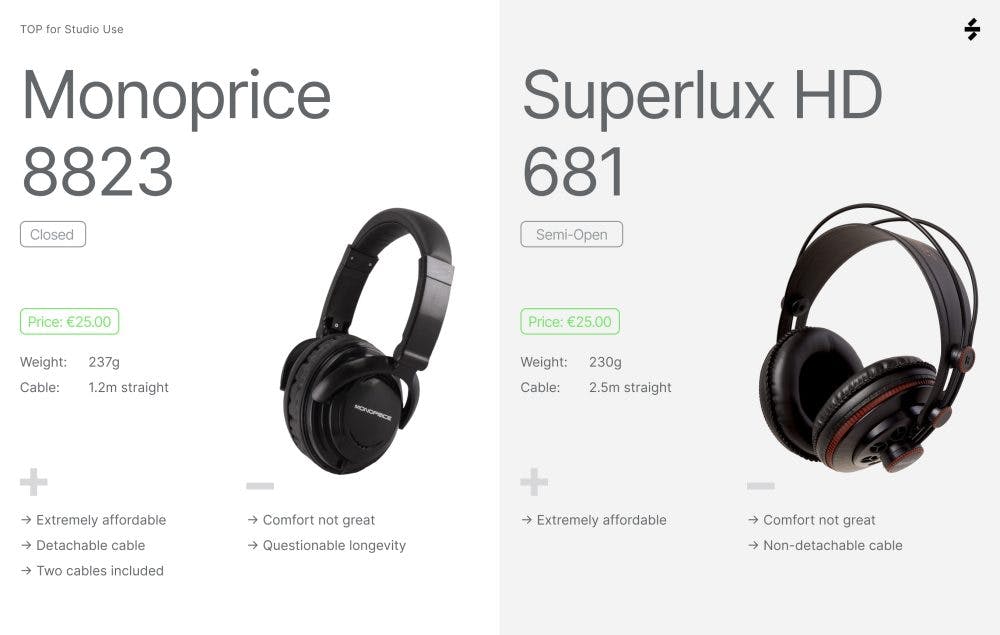
1. Monoprice Premium Hi-Fi DJ Headphone 8823
If you’re on a budget and you need headphones for production or mixing – these closed-back headphones are what you are looking for. These cans deliver where it counts and can be considered a serious monitoring tool once calibrated. Read the full headphone review here
2. Superlux HD 681
These semi-open headphones are an amazing deal. They sound relatively good on their own, but really become alive after individual calibration. Yes, they have their shortcomings, but at the extremely affordable price of €25 / $25, it’s hard to be picky. Read the full review here
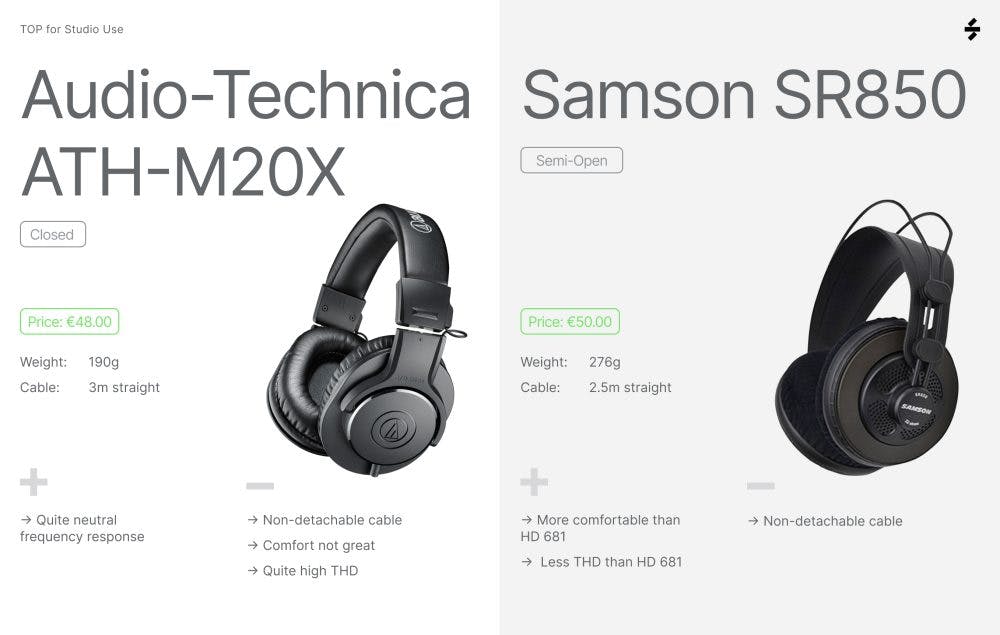
Audio-Technica ATH-M20x and Samson SR850 Headphones
3. Audio-Technica ATH-M20x Studio Headphone
ATH-M20x’s are very natural-sounding closed-backs fit for mixing work and pack a considerable bang for your buck. For genres that don’t require surgical precision in sub-bass region, M20x is arguably a better choice than M50x when it comes to studio work. Read the full review here
4. Samson SR850 Headphones
These semi-open headphones can bring out details in recordings and make it easier to hear imperfections. However, they don’t have the best build quality and don’t have a non-detachable cable. Overall, for the budget-friendly price, these headphones offer good frequency response consistency and have a wide, spacious soundstage.
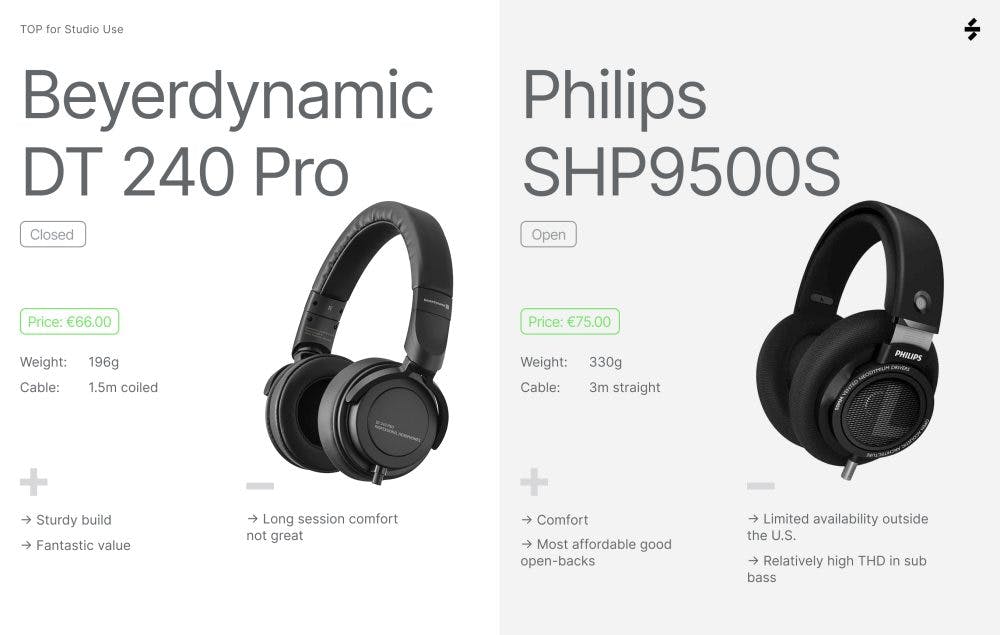
5. Beyerdynamic DT 240 Pro Studio Headphone
These are the best over/on-ear headphones that €70 can buy, as long as comfort is not an issue. The excellent build and compact size make them especially great for electronic music producers that are after a single pair of headphones that are suited for both studio work and DJ duties. Read the full review here
6. Philips SHP9500S Headphones
Very comfortable open-back headphones that deliver a good, well-balanced sound and spacious soundstage. For the price, these are very durable headphones but they are also very bulky. Another minus is the relatively high THD in the sub-bass.

7. Audio-Technica ATH-M50x
The M50x has a great fit that doesn’t get in the way of everyday use. Unlike most on-ear headphones, this one doesn’t rely on a strong clamp to achieve a good seal, therefore it is fairly comfy even in longer sessions. No doubt, it’s a great headphone with relatively few shortcomings, but the tuning might be too “fun” to be considered reference grade. Nevertheless, these headphones are a great candidate for calibration due to the low inherent THD and little change in tonality depending on how they’re placed on one’s ears. Watch the full video review here
8. Beyerdynamic DT 770 Pro Headphones
These closed-back headphones are durable, lightweight, sits comfortably on the head and most of the parts are replaceable. The top end gets rather harsh and fatigue can set in quickly. But overall these headphones have what it takes to be the go-to closed back for studios. Read the full review here
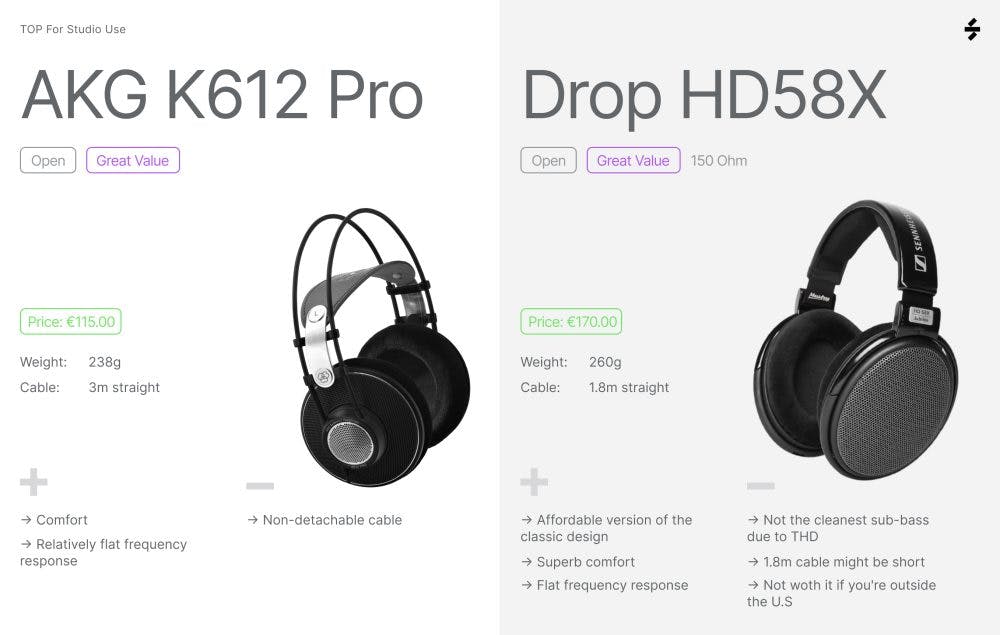
9. AKG K612 Pro Headphones
These open-back headphones deliver nearly everything one might look for in mixing headphones, yet manages to keep the cost down. High comfort, natural sound, low THD, great adaptiveness make these headphones a really reliable studio tool. Read the full review here
10. Drop HD58X Headphones
These are among the most comfortable open-back headphones that deliver flat frequency response out of the box. Durable and great for long working hours. But does not offer the best price-performance for those outside of the US.
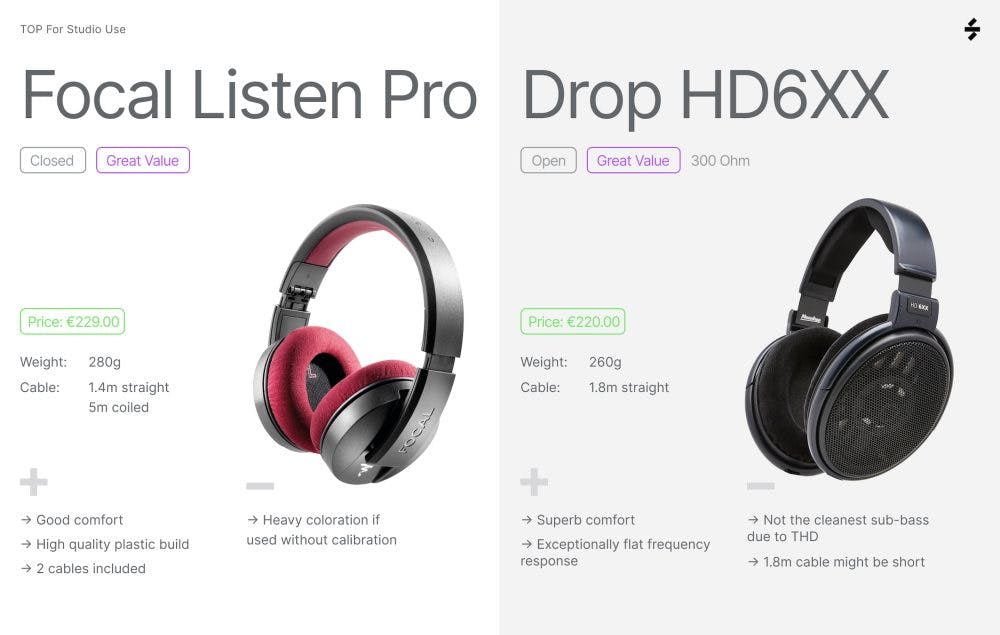
11. Focal Listen Pro
These closed-back headphones offer great comfort and superb build quality. The sound, however, is pretty sub-par and mid-frequency coloration makes mixing near impossible. Pair them with calibration though and there’s very little left to complain about. Read the full review here
12. Drop HD6XX
These open-back headphones deliver truly flat frequency response and a spacious soundstage. Very neutral, well balanced, comfortable for long sessions but like most open-back headphones, they’re lacking some low-bass.
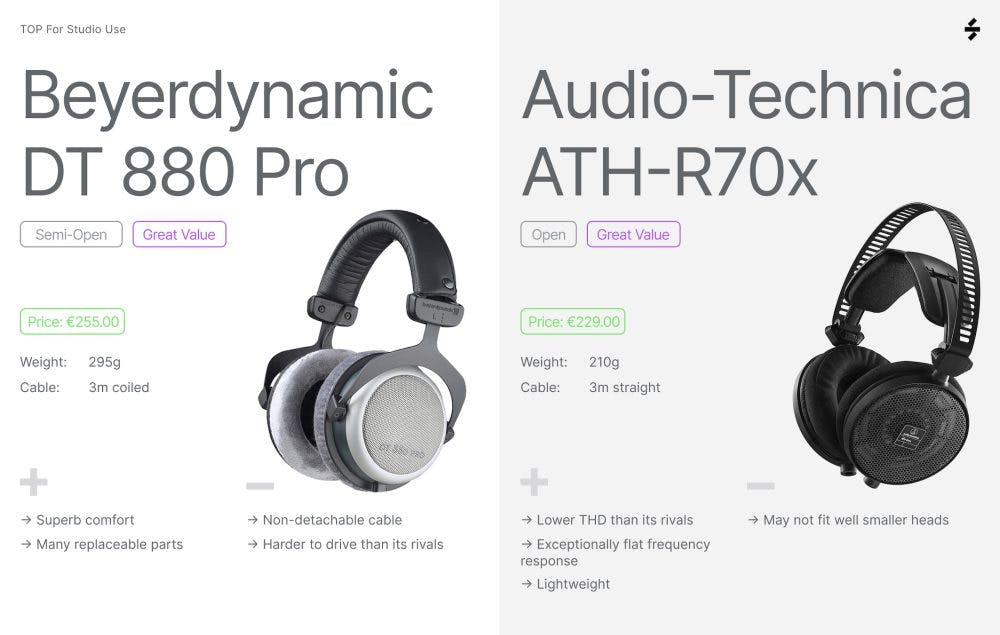
13. beyerdynamic DT 880 Pro
These are high quality headphones that offer a solid build, great comfort, and quite an affordable price. While the sound out of the box is bright, pair them with calibration and they’ll deliver astounding accuracy. Highly recommended to anyone looking for headphones that excel in production, mixing and mastering. Read the full review here
14. Audio-Technica ATH-R70x
These headphones offer great comfort, low THD for an open-back dynamic headphone, and exceptionally flat frequency response. Nevertheless, build quality doesn’t match the asking price. Read the full review here

15. Sennheiser HD 600
These open-back headphones deliver a good, well-balanced frequency response, great comfort, and a spacious soundstage. They lack a little low-end bass but that can be easily corrected by applying calibration
16. Sennheiser HD 650
Apart from the weak bass response, there isn’t much correction required to get these open-back headphones absolutely perfect. Once calibrated, we can’t recommend Sennheiser HD 650 enough to anyone looking for production, mixing, and mastering studio headphones. Read the full review here
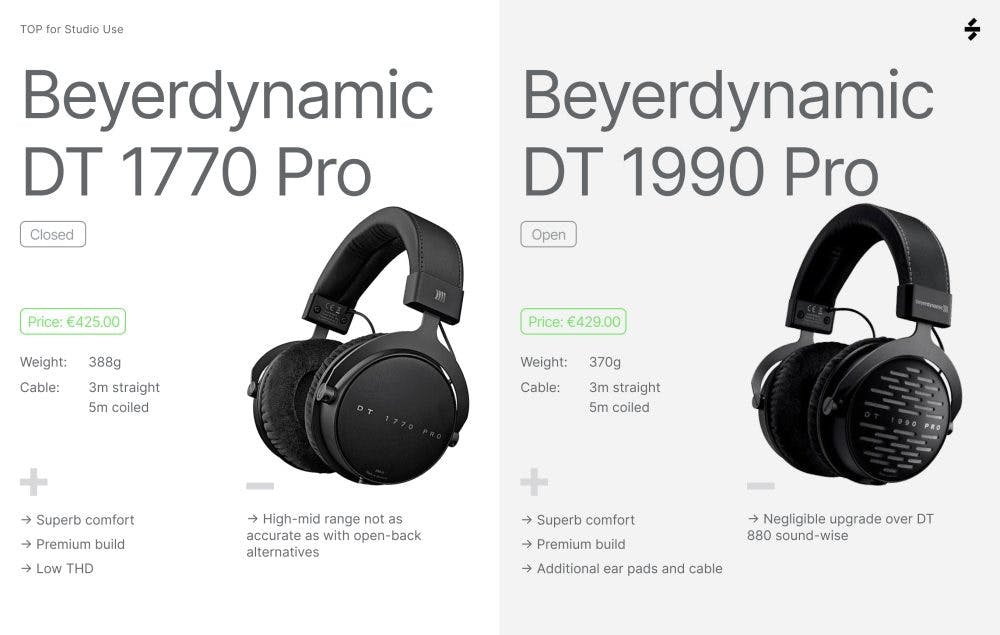
17. Beyerdynamic DT 1770 Pro Studio Headphone
There are no more affordable headphones that can match their build and bass performance. These premium-build headphones offer low THD and deliver consistent frequency response. Read the full review here
18. Beyerdynamic DT 1990 Pro
These open-back headphones have the most premium look and feel. They deliver a well-balanced sound, extended bass and spacious soundstage. But despite the comfortable design, these headphones can feel a bit tight at first.
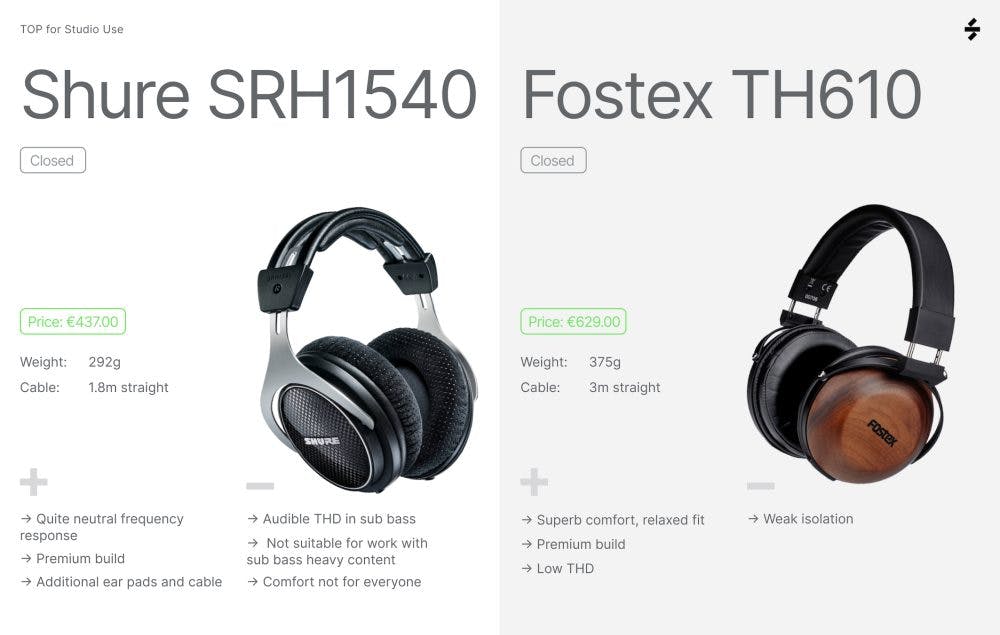
19. Shure SRH1540 Headphones
If only there wasn’t the THD issue and the comfort was more universal, SRH1540 would be the best closed-back studio headphones for anyone, period. However, If you work with acoustic music, classical, rock music, basically anything without prominent sub bass – these are the best closed-back studio headphones you can buy. Read the full review here
20. Fostex TH610
These premiums closed-back headphones are very comfortable and have durable build quality. They offer a wide soundstage and low THD. However, they are a bit bright in highs and have weak isolation.
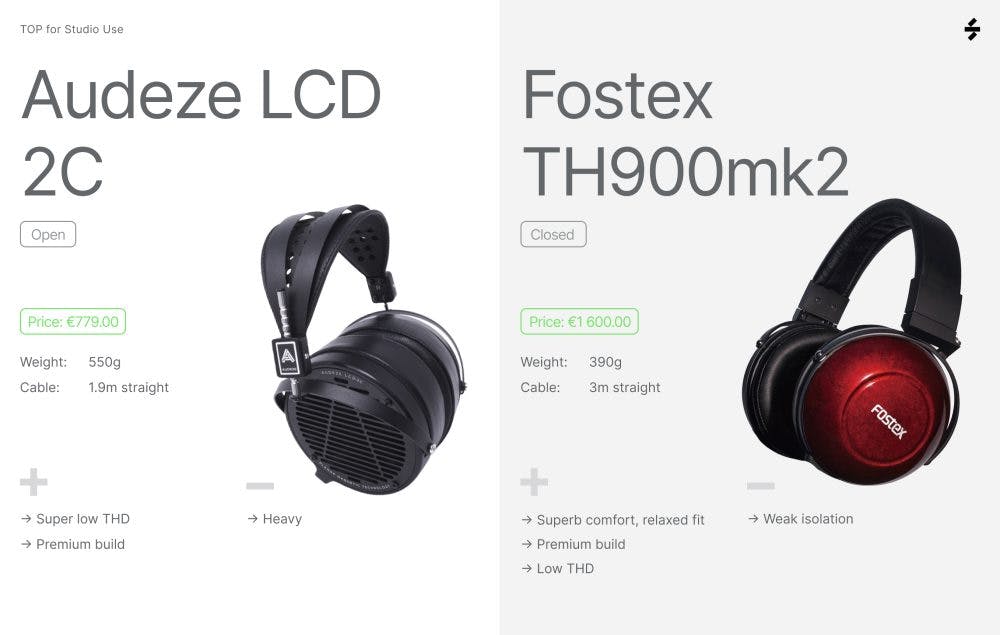
21. Audeze LCD 2C
Great-sounding open-back headphones with super low THD. While these headphones offer a premium build, they are very heavy, therefore are not great for long mixing sessions. Also, they have poor isolation by design.
22. Fostex TH900mk2
The sound of these closed-back headphones is very open but passive noise cancellation is weak and sound leakage considerable. As studio headphones they are great, yet there are better options out there, sold at more reasonable prices. Read the full review here
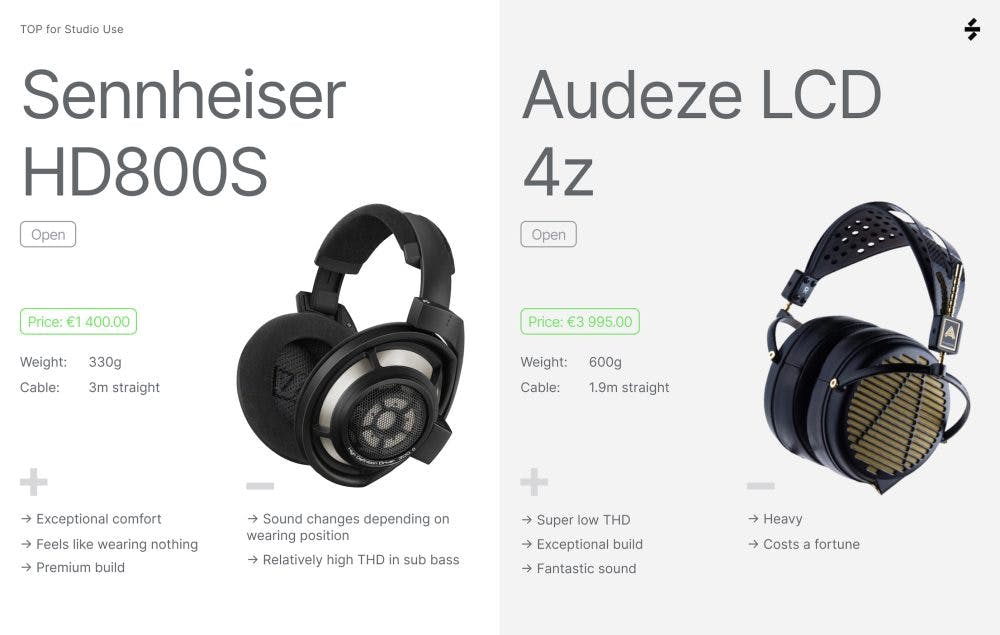
23. Sennheiser HD800S Headphones
These open-back headphones offer great comfort and retain its superb resolution and imaging even after flattening its frequency response. Brightness is gone and the sub-bass completes the picture. The sub-bass will distort at a higher volume, bass heads should look at orthos. Read the full review here
24. Audeze LCD 4z Headphones
These open-back headphones are very comfortable to wear and they deliver a well-balanced soundstage, super low THD, and wide dynamic range. The biggest drawback is the weight of these premium-build headphones and the fact that you’ll have to rob a bank to get a pair.
Read the full Headphone Buying Guide with more headphone options here.



